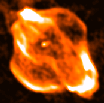8 May 1998
AUSSIES FIRST TO SEE LIKELY BLACK HOLE BIRTH
Australian astronomers may be witnessing what has never been seen before
- a black hole being born as the core of a supermassive star collapses in
on itself.

Contacts:
Professor Ron Ekers, Director, CSIRO Australia Telescope National Facility
Tel: 02 9372 4301 (BH), 02 9869 8656,
email: director@atnf.csiro.au
Dr Brian Boyle, Director, Anglo-Australian Observatory
Tel: 02 9372 4811 (BH),
email: director@aaoepp.aao.gov.au
Dr Elaine Sadler, University of Sydney
Tel: 02 9351 2622 (BH), 02 9922 6368 (AH),
email: ems@physics.usyd.edu.au
Dr Dale Frail, US National Radio Astronomy Observatory
* 16 hours behind Eastern Australian Time*
Tel.: 1-505-835-9115 (home), 1-505-835-7338 (work),
email: dfrail@nrao.edu
See also the
ATCA Gamma-Ray-Burst Page,
Optical Pictures of ESO184-82,
Selected GRBs and
APOD




